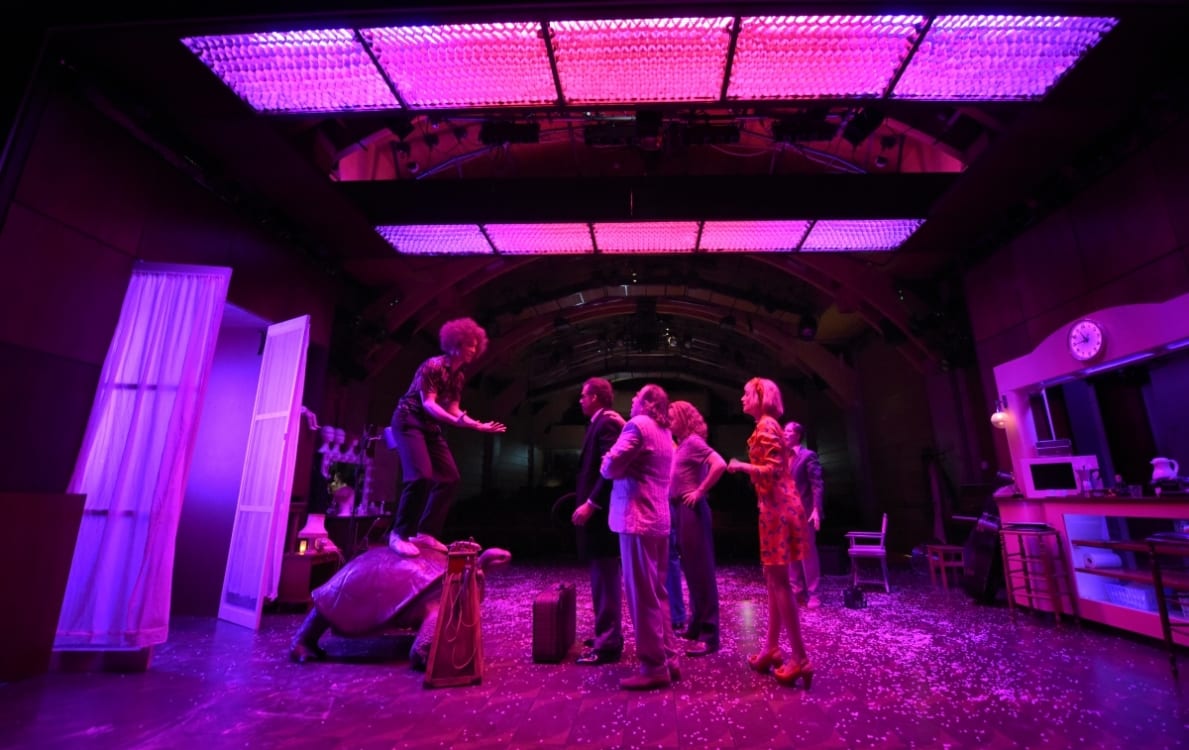Entering the Théâtre du Vieux-Colombier for the first time to see Le Voyage de G. Mastorna, I see a confused man who is already on stage, walking in the middle of spectators who are seated on both sides of the setting. Before the beginning of the play, Serge Bagdassarian is already in the character of Federico Fellini, the omniscient director, who shot, slept and lived in the studios of Cinecitta. Unlike the other characters, he does not evolve on set, he and his mind are the set, and we discover him as we discover the face of a huge statue and other bits and pieces of scenery, all piled up behind the spectators sitting opposite us.
The Journey of G. Mastorna is the name of Fellini’s impossible project, and the name of the play that settles him as a character whose journey is the making of a film. Ironically, since the beginning of the play, this project seems to be falling apart: a piece of the ceiling falls down on stage, sounding like an “action!”, and the play starts.
It all begins with a mystic scene, as Federico consults a mage who warns him about the making of his film. With his voice from beyond the grave, the mage (Jérémy Lopez) gives an unexpected, oddly superstitious start to the play. Jérémy Lopez stands out as both the bald, troubling mage, and Rino: the long-haired, grotesque assistant director and handyman. Even if he is a secondary character, he brilliantly embodies the main two tones of the play, constantly oscillating between absurd humour and something else that is darker and hidden, almost fantastic.
The absurd dimension of the play comes from Fellini’s project itself: Giuseppe Mastorna, a famous cellist, lands in a strange city after a plane crash, and is stuck in this place where he meets peculiar characters, each as strange as the next. When he realises he is actually dead and he is stuck there, the inhabitants of this afterlife that he calls “a miserable party” help him look back on his life. What makes all of this even more absurd is that the director wrote this script without an ending, and when Fellini walks in circles, talking on a phone that is not even plugged and describing a monumental project when he’s alone on stage, this absurdity becomes tragic. The director, looking for some unreachable truth and saying his actors are frauds, seems doomed to despair and madness.

The way the realistic set becomes more and more fantastic and dreamlike is efficient, in a way that the spectator feels led to a space that is always somewhere on the edge between a dream and a nightmare. This comes from the acting (Bagdassarian, already seen as the memorable and eccentric Dick in Christiane Jatahy’s La Règle du Jeu, is both hilarious and touching as the tortured Italian director) but also some unlikely elements like a giant turtle or a man walking around in a diving suit, and the use of the lighting that becomes progressively more hazy, colourful and psychedelic. The costumes are great too, because they give a nice 70’s vibe and also convey a very Fellinian atmosphere – for example, Georgia Scalliet wears a dress that exaggerates her curves in a grotesque way. Scalliet, who plays an actress, shares her doubts about the job she chose, and opposite her, Laurent Lafitte is a surprising but convincing choice as the faded, doubting Marcello Mastroianni, acting like a defeatist puppet.
Even if the insisting references to Fellini’s films are bothering, and staging the director at work could have been tricky, it is made in a clever way, mixing the absurdity of such a shooting with how it resonates with the director’s existential doubts. The bifrontal device highly contributes to the originality of the play: according to its director Marie Rémond, it highlights the character’s imprisonment, but for the spectators, it creates a rarely seen proximity and allows to feel like they are on set, shooting the film too, taking part in the making of this collective dream. Because what is the shooting of a film, if not the making of a collective dream?
And just like one can brutally awake from a dream, the play stops mid-sentence : “What happens next, honestly, I don’t know yet…” and Fellini is interrupted by the loud applause of the audience when the lights go off.

